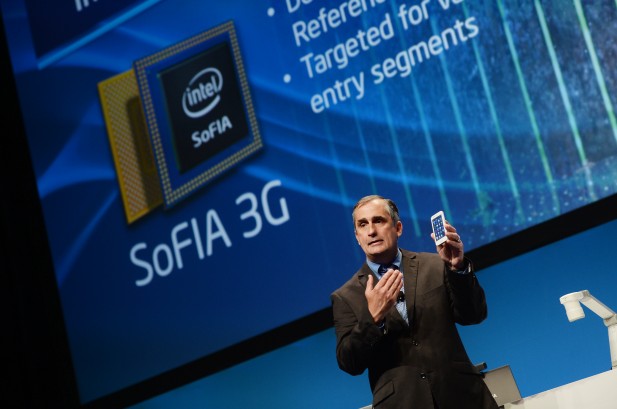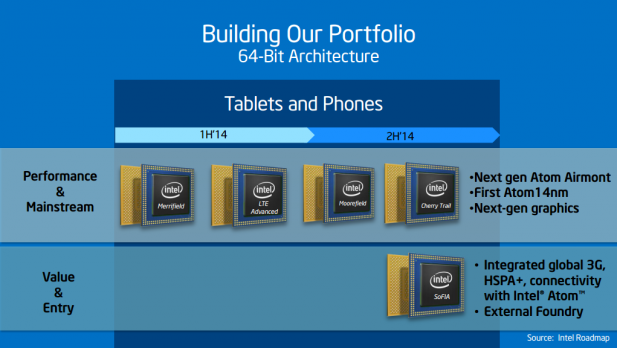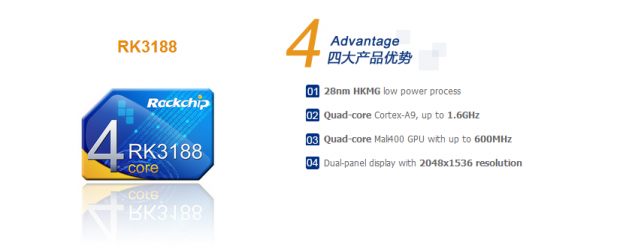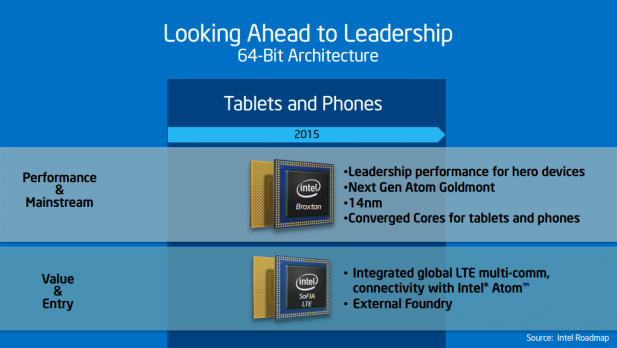Today in a press release Intel announced that it was entering a strategic partnership with Rockchip to build a new Atom-based quad-core SoC with Intel’s 3G chipset that will become a new addition to Intel’s upcoming soFIA family of application processors. This new SoC will be designed by Rockchip to meet the exact needs of the Chinese tablet market. In addition to leveraging Intel’s core mobile IP and Rockchip’s design expertise and market specific IP this chip will also use Intel’s soFIA architecture and is set to be released in the first half of 2015.
Prior to this announcement Intel had only had two chips in the soFIA family of applications processors. The first product is a dual core Atom-based SoC with a 3G modem that will arrive in Q4 of this year. The other product is a quadcore Atom-based SoC with Intel’s own LTE modem that should arrive in the first half next year. The chip that was announced today is a quadcore part with a 3G modem and will slot in between the offerings that Intel had already planned for the soFIA family.
As part of the agreement between Intel and Rockchip both companies will offer the SoC created in their partnership to their respective customers. It will be an Intel branded part, but the branding will reflect the fact that this chips was designed by Rockchip. For its part Rockchip will be contributing the graphics, I/O, and market specific IP need to make this chips a success in the extremely cost sensitive Chinese tablet market. Intel’s CEO said that he see this partnership as a way to address the extreme growth going on in the Chinese tablet market.
Intel was very clear in its remarks that there would be no money changing hands in this partnership. Intel is not buying or investing in Rockchip, rather it is purely a partnership based on around building a product to meet the needs of a very specific market. So far this the first partnership where Intel has engaged in with a competitor in the mobile market. While Intel’s said that it isn’t ruling out the possibility that we’ll see more partnerships of this kind in the future, it did say that at this time it had no other partnerships in the works.
Intel also clarified its target for the chips in the soFIA family saying that they expected these chips to end up in tablets ranging in cost from less than $100 to up to $150. The other interesting thing that came up in the Q&A session was that none of these parts will be receiving any assistance from Intel contra-revenue program. These soFIA chips will float or sink based purely on their own technical and economic merits rather than on the size of the payments doled out to the OEMs. As is par for the course Rockchip will be producing a reference design tablet that integrates the SoC that it’s building in partnership with Intel and handing it out to its partners.
Perhaps one of the most interesting things about this deal is that this new SoC will be fabbed at TSMC on their 28nm node. It will be the first mass-produced product using Intel’s small core to be exposed into silicon outside of the company’s own fabs. Of course the next generation of Intel’s application processors will be fabbed in-house, but for now Intel has opted to use TSMC to leverage Rockchip’s experience with them and hopefully minimize time-to-market on this product.
Here’s where things get a little bit less clear, Intel did not say that this partnership chip had taped out or that they were sampling it to partners. In fact Intel’s CEO went as far as to say that the exact features of this chip outside of its basic makeup had yet to be defined. To us here at SemiAccurate this means two very important things: the SoC is still being designed and has yet to be finalized or sent off to the fab. As it stands now Intel has one year to finish the design of this chip and get it out on the shelves.
This isn’t an unreasonable proposition given the time period, but the margin for error is limited. It’s likely that Intel and Rockchip can only afford one major set back without losing the ability to meet their schedule. As far as risk factors go the biggest potential problem is Intel’s ability to communicate effectively with Rockchip and Rockchip’s ability to work with Intel’s IP building blocks. That said Rockchip has a lot of experience building SoCs at TSMC and integrating vastly different pieces of IP from its partners while keeping costs in check. There is a certain amount of risk to this deal for both sides, but if there were any two companies that could work together to build this product Rockchip and Intel would be our top choices.
Taking a step back and looking at this from a historical perspective it’s hard not to notice that Intel has effectively begun to license the x86 ISA again under the pressure of ARM’s entry-level assault. This is but a small stepping stone in Intel’s plan to crush ARM and take over the mobile market, but it should make crystal clear the lengths to which Intel’s management group is willing to go to offer products for every market. When this time next year rolls around there will be four companies selling x86-based chips which is a mile-stone worth pausing for. That said if you’re a SemiAccurate subscriber then you’ve already known about all of this since the beginning of April.S|A
Thomas Ryan
Latest posts by Thomas Ryan (see all)
- Intel’s Core i7-8700K: A Review - Oct 5, 2017
- Raijintek’s Thetis Window: A Case Review - Sep 28, 2017
- Intel’s Core i9-7980XE: A Review - Sep 25, 2017
- AMD’s Ryzen Pro and Ryzen Threadripper 1900X Come to Market - Aug 31, 2017
- Intel’s Core i9-7900X: A Review - Aug 24, 2017



